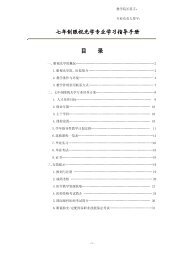Refractive Lens Surgery
Refractive Lens Surgery
Refractive Lens Surgery
You also want an ePaper? Increase the reach of your titles
YUMPU automatically turns print PDFs into web optimized ePapers that Google loves.
total diameter of 13 mm, 360° sharp edge<br />
and 0° haptic angulation (Fig. 14.3, model:<br />
MA60D3).<br />
The AcrySof ReSTOR lens is already marketed<br />
in Europe, and Food and Drug Administration<br />
approval in the USA for a cataract<br />
indication is avoilable.<br />
Chapter 14 AcrySof ReSTOR Pseudo-accommodative IOL 139<br />
Fig. 14.2.<br />
AcrySof<br />
ReSTOR<br />
in vitro<br />
Fig. 14.3. Implanted MA60D3 (investigative lens)<br />
14.2 Preoperative Considerations<br />
Beside routine preoperative ophthalmologic<br />
examinations and detailed discussion of the<br />
pros and cons of a ReSTOR lens implantation,<br />
the following points are worth considering in<br />
the preoperative patient selection and preparation<br />
of the surgery:<br />
∑ Currently the ReSTOR IOL is available<br />
from 16 to 25 D, thus an early preoperative<br />
IOL calculation is necessary to assure that<br />
an IOL with the desired power is available.<br />
However,the diopter range will be expanded<br />
in the future by Alcon.<br />
∑ Patients with significant pre-existing ocular<br />
pathology (e.g. age-related macular degeneration,<br />
diabetic maculopathy, etc.)<br />
should not be considered for implantation.<br />
We also strongly recommend amblyopic<br />
eyes not to be considered.<br />
∑ It is extremely important for patient satisfaction,<br />
in refractive lens exchange procedures,<br />
to achieve a distance emmetropia of<br />
0 to +0.5 D, thus a meticulous biometry is<br />
necessary. If possible, two independent<br />
technicians should perform the biometry,<br />
as best possible IOL calculations are crucial.<br />
Furthermore, the A-constant of the<br />
ReSTOR lens (118.2 D for ultrasound<br />
measurements and 118.6 for IOL Master)<br />
is subject to further evaluation and should<br />
be customized by the surgeon to achieve<br />
best refractive results.<br />
∑ Corneal astigmatism greater than 1.5 D is<br />
difficult to correct accurately by incisional<br />
procedures within the framework of a refractive<br />
lens exchange surgery; thus we<br />
recommend either not to consider such<br />
patients for ReSTOR IOL implantation or<br />
to plan for a secondary post-implantation<br />
refractive procedure, e.g. laser-assisted insitu<br />
keratomileusis (LASIK), in cases of<br />
unsatisfactory visual results. Generally,<br />
limiting the amount of preoperative<br />
corneal astigmatism to less than 1 D is advised.



